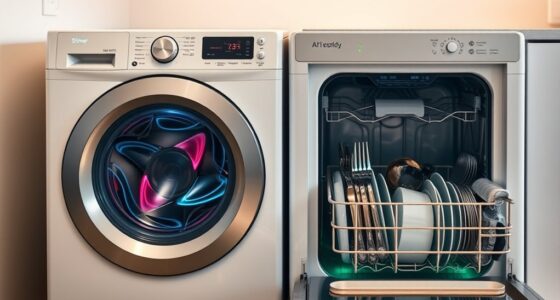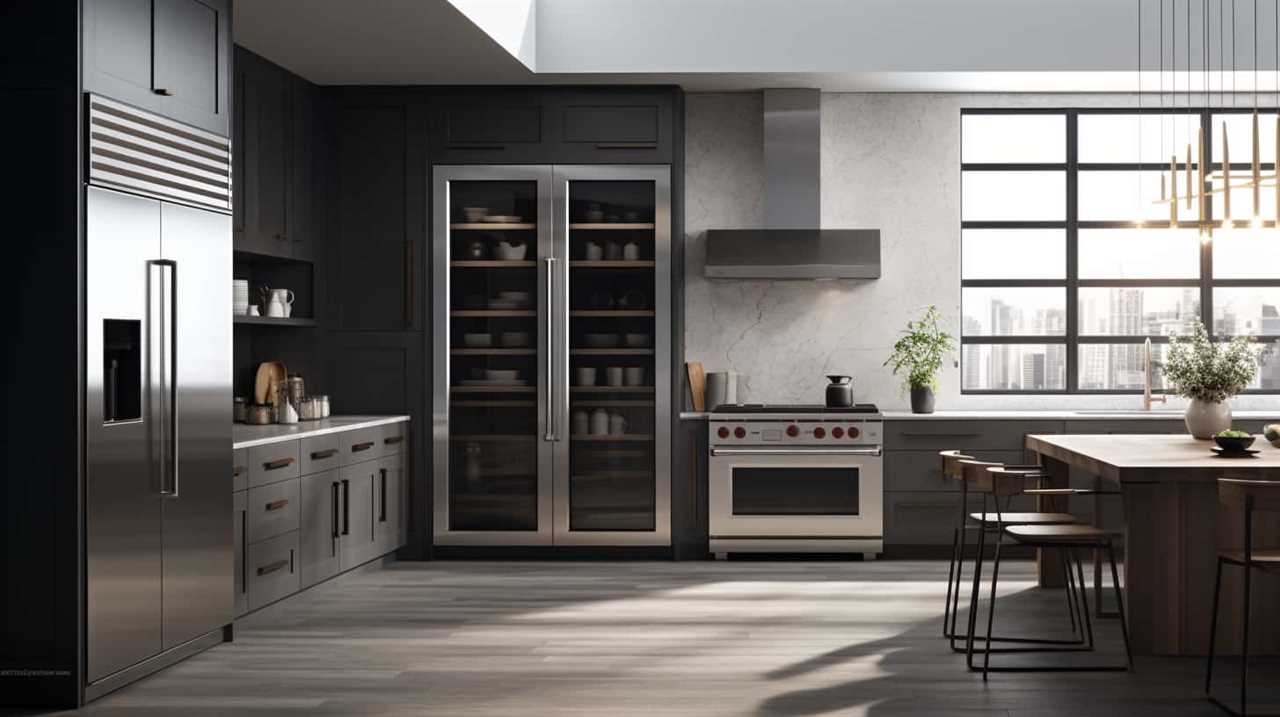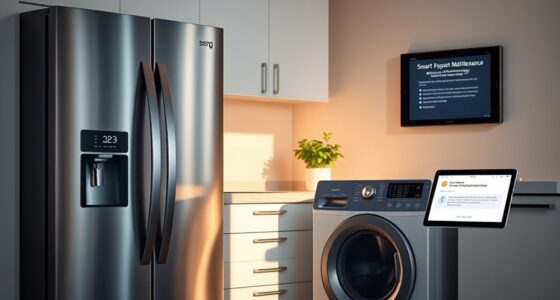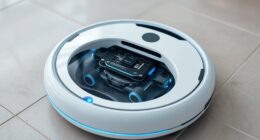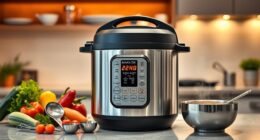Were you aware that more than 60% of households in the United States now possess at least one smart home appliance? The integration of IoT with smart home devices has gained significant popularity, transforming the way we engage with our living spaces.
In this article, we will explore the benefits, challenges, and security measures associated with integrating IoT into smart home appliances. We will also delve into how IoT can enhance energy efficiency and automate various aspects of our homes.
Furthermore, we will discuss future trends in IoT-enabled smart home appliances and provide case studies of successful integration. So, if you are eager to master the art of integrating IoT with your smart home appliances, keep reading!
Key Takeaways
- IoT integration revolutionizes the way we interact with our homes.
- Energy monitoring allows real-time tracking and identification of areas for energy efficiency improvements.
- Convenience and control enhance the security and safety of our homes.
- Compatibility issues arise due to different communication protocols and technologies.
Benefits of IoT in Smart Homes
We have seen numerous benefits of integrating IoT into our smart homes. One of the key advantages is energy monitoring. With IoT devices, we can now easily track and monitor our energy consumption in real-time. This allows us to identify areas where we can reduce wastage and make our homes more energy-efficient. By analyzing the data collected by these devices, we can also gain valuable insights into our energy usage patterns and make informed decisions on how to optimize our energy consumption.

Another significant benefit of IoT in smart homes is remote control. With IoT-enabled devices, we can now control and monitor various aspects of our homes from anywhere, using our smartphones or other connected devices. This means that we can adjust the temperature, turn lights on or off, and even lock or unlock doors, all with just a few taps on our screens. This level of convenience and control not only enhances our overall comfort but also improves the security and safety of our homes.
Key Components of Smart Home Appliances
To understand the key components of smart home appliances, let’s delve into the various elements that make these devices intelligent and connected. A functionality analysis reveals that there are three main components that enable the smart features of these appliances: sensors, connectivity modules, and control units.
Sensors play a crucial role in gathering data from the environment. These sensors can detect various parameters such as temperature, humidity, light intensity, and motion. They provide valuable information that enables the appliances to adjust their behavior based on the user’s preferences or environmental conditions.
Connectivity modules are responsible for establishing communication between the smart home appliances and other devices or platforms. These modules utilize technologies like Wi-Fi, Bluetooth, or Zigbee to connect the appliances to a central hub or directly to the internet. This connectivity allows users to control and monitor their appliances remotely using smartphones or other smart devices.

Control units act as the brain of the smart home appliances. They process the data collected by the sensors and execute the desired actions based on predefined algorithms or user inputs. These control units can be embedded within the appliance itself or reside in a central hub that controls multiple devices.
Integration Challenges in Smart Home Appliances
When it comes to integrating IoT with smart home appliances, there are several challenges that need to be addressed.
Firstly, security risks in integration pose a significant concern, as interconnected devices can create vulnerabilities in the system.
Secondly, compatibility with existing systems can be a hurdle, as different manufacturers may use different protocols and standards.
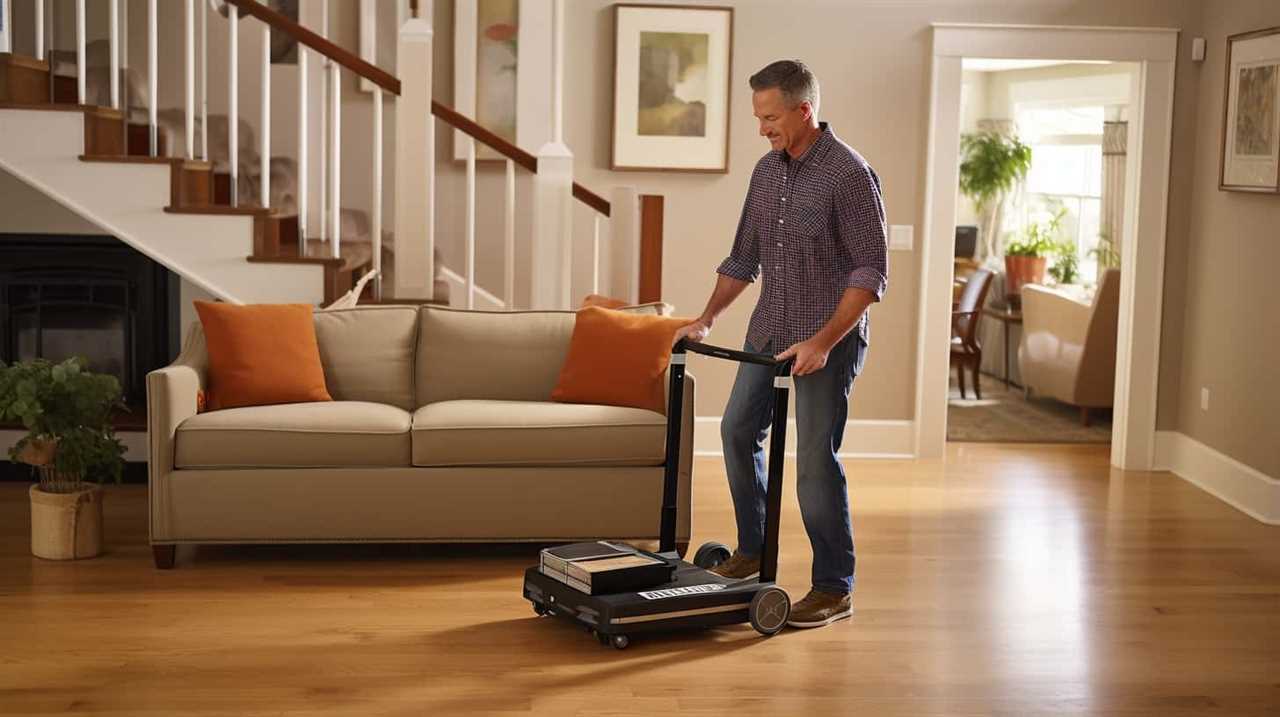
Lastly, the complexity of user interfaces can make it difficult for users to navigate and control their smart home appliances effectively.
These challenges need to be carefully considered and overcome to ensure a seamless integration of IoT in smart homes.
Security Risks in Integration
With the integration of IoT in smart home appliances, we must be aware of the security risks that come with this integration. Security breaches and privacy concerns are two major issues that arise when connecting these devices to the internet. As our homes become more connected, the potential for unauthorized access and data breaches increases. Hackers can exploit vulnerabilities in the system, gaining access to personal information or even control over the devices themselves.
Additionally, the collection and storage of personal data by these appliances raise concerns about privacy. Users need to be cautious about the data they share and who’s access to it. To mitigate these risks, manufacturers and users must prioritize security measures such as encryption, strong authentication, and regular software updates. By addressing these concerns, we can ensure that the integration of IoT in smart home appliances is done in a secure and responsible manner.
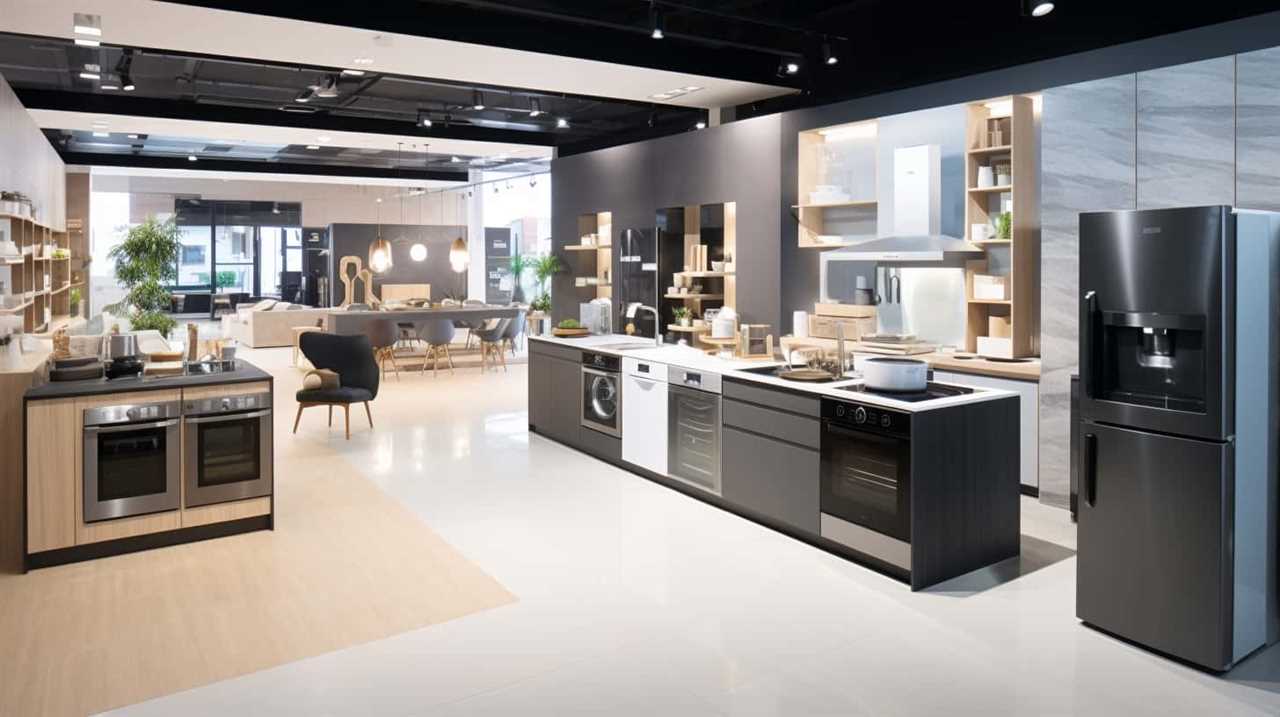
Transitioning into the subsequent section about compatibility with existing systems, it’s also crucial to consider how these new IoT devices will interact with our current home setups.
Compatibility With Existing Systems
As we delve into the challenges of integrating IoT with smart home appliances, it’s essential to consider how these new devices will seamlessly interact with our existing home setups.
One of the key compatibility issues lies in the existing systems limitations. Many homes have different brands and generations of appliances, each with its own communication protocols and technologies. This can create interoperability challenges when trying to connect IoT devices to these systems. For example, a smart thermostat may not be compatible with an older HVAC system, or a smart refrigerator may struggle to communicate with a legacy home automation hub. Achieving seamless integration requires bridging the gap between these disparate systems, either through hardware adapters or software updates.
By addressing these compatibility issues, we can ensure that IoT devices can effectively interact with our existing home setups, maximizing the benefits of a smart home.
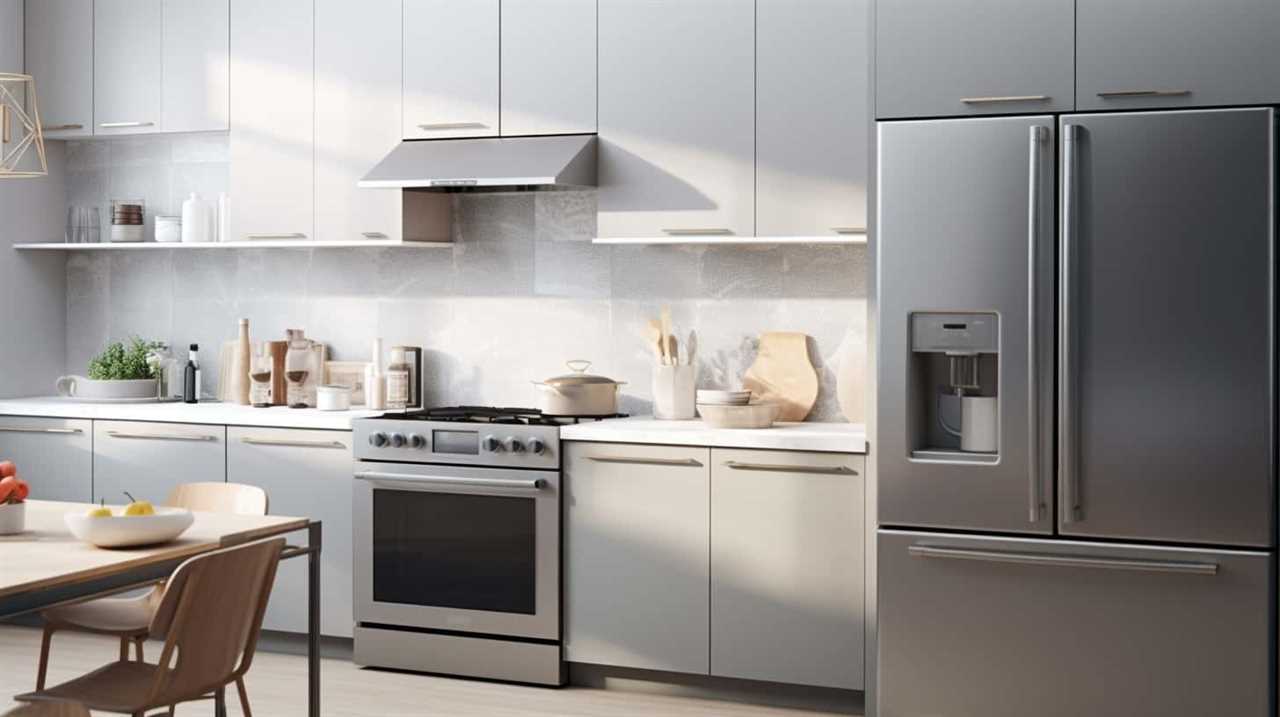
This brings us to the next challenge: user interface complexity.
User Interface Complexity
To address the challenges of integrating IoT with smart home appliances, we must navigate the complexities of user interface design. The user interface serves as the bridge between humans and machines, allowing us to interact and control our appliances.
However, designing an intuitive and efficient user interface for smart home appliances poses unique challenges. With the increasing complexity of IoT systems, it’s crucial to ensure that users can easily understand and interact with their appliances. This requires careful consideration of user experience improvement, taking into account factors such as simplicity, responsiveness, and visual clarity.
By prioritizing user interface design, we can enhance the overall usability and convenience of smart home appliances, making them more accessible and enjoyable for users.
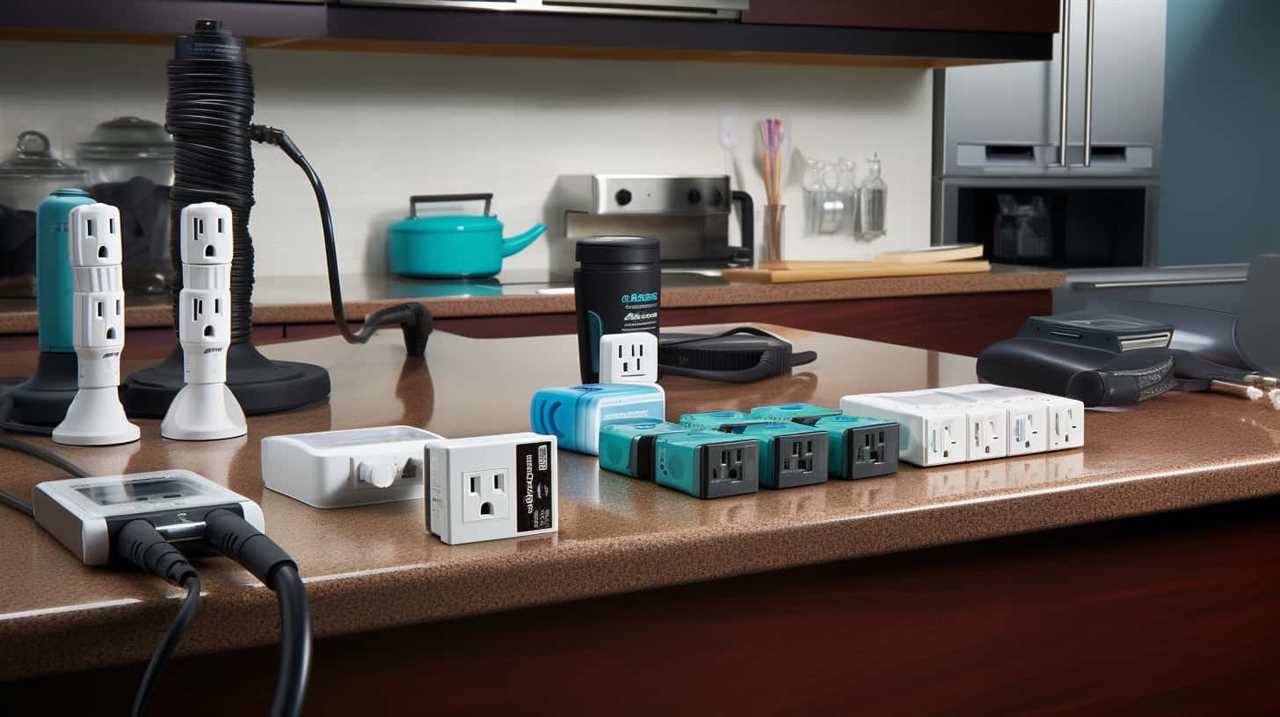
Now, let’s delve into the next section to explore the essential security measures for IoT-enabled appliances.
Security Measures for IoT-enabled Appliances
When it comes to IoT-enabled appliances, there are several security measures that need to be considered.
One of the main concerns is data privacy, as these appliances collect and transmit sensitive information.
Authentication and authorization protocols are also crucial to ensure that only authorized individuals can access and control these devices.
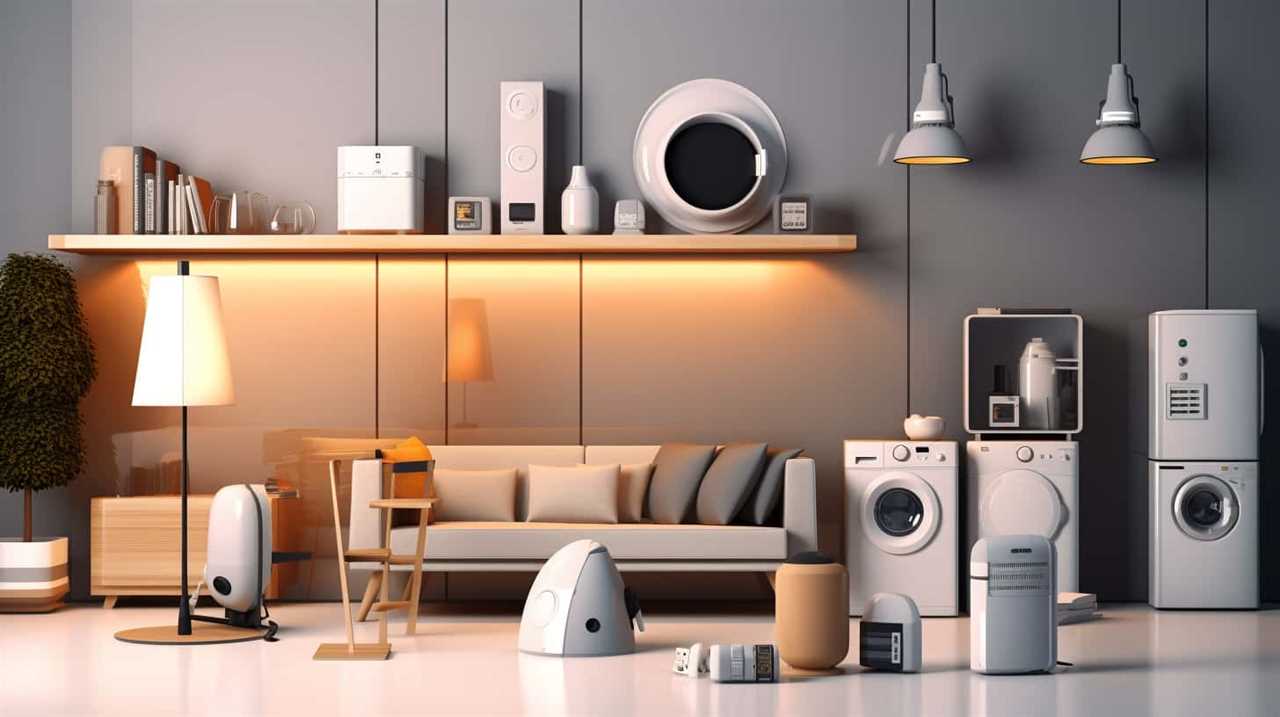
Additionally, the vulnerability to hacking is a major issue, as any security breach can lead to unauthorized access or manipulation of the appliances.
Data Privacy Concerns
While ensuring data privacy is crucial, we implement robust security measures for IoT-enabled appliances. Protecting sensitive user data from data breaches is a top priority for us. We understand the importance of regulatory compliance in safeguarding personal information and strive to meet all relevant standards. Our security measures include encryption, authentication, and regular software updates to address any vulnerabilities. By encrypting data, we ensure that it remains secure during transmission and storage. Authentication protocols verify the identity of users and prevent unauthorized access. Regular software updates help to mitigate any potential security risks by patching vulnerabilities as they are discovered. Our commitment to data privacy extends beyond regulatory compliance, as we continuously improve our security measures to protect our customers’ information.
| Security Measure | Description | Implementation |
|---|---|---|
| Encryption | Converts data into a code that can only be deciphered with a secret key, ensuring confidentiality | Strong encryption algorithms such as AES are used to encrypt data at rest and in transit |
| Authentication | Verifies the identity of users and devices, preventing unauthorized access | Multi-factor authentication, including passwords, biometrics, and digital certificates, is implemented to ensure only authorized users can access the system |
| Software Updates | Regularly updates the software to address security vulnerabilities and ensure the latest protection | Automated updates are scheduled, and patches are applied promptly to address any identified vulnerabilities |
Authentication and Authorization
Our commitment to data privacy extends to implementing robust authentication and authorization measures for IoT-enabled appliances.
Authentication protocols are essential for ensuring that only authorized individuals or devices can access and interact with the smart home appliances. This involves verifying the identity of the user or device through various methods such as passwords, biometric data, or digital certificates.

Additionally, access control mechanisms are implemented to regulate the actions and privileges granted to different users or devices. This helps prevent unauthorized access, tampering, or misuse of the appliances and their associated data.
Vulnerability to Hacking
To address the vulnerability to hacking, we implement robust security measures for IoT-enabled appliances. These measures are crucial for ensuring the safety and privacy of users’ data.
Here are four cybersecurity measures that are commonly implemented to prevent hacking:
- Encryption: We use strong encryption algorithms to protect the communication between IoT devices and the central server. This ensures that the data transmitted is secure and can’t be intercepted or manipulated by hackers.
- Access controls: We implement strict access controls to prevent unauthorized access to IoT devices. This includes strong authentication mechanisms, such as passwords or biometric verification, to ensure that only authorized users can access the devices.
- Regular software updates: We provide regular software updates to IoT devices to patch any security vulnerabilities. This helps in keeping the devices secure by fixing any known vulnerabilities.
- Intrusion detection systems: We deploy intrusion detection systems that continuously monitor the network traffic and detect any suspicious activities. This allows us to quickly respond to potential security breaches and take appropriate actions.
Enhancing Energy Efficiency With Iot in Home Appliances
One major way to improve energy efficiency in home appliances is by integrating IoT technology. By connecting appliances to the internet and enabling communication between devices, IoT allows for remote monitoring and control, resulting in enhanced energy conservation.
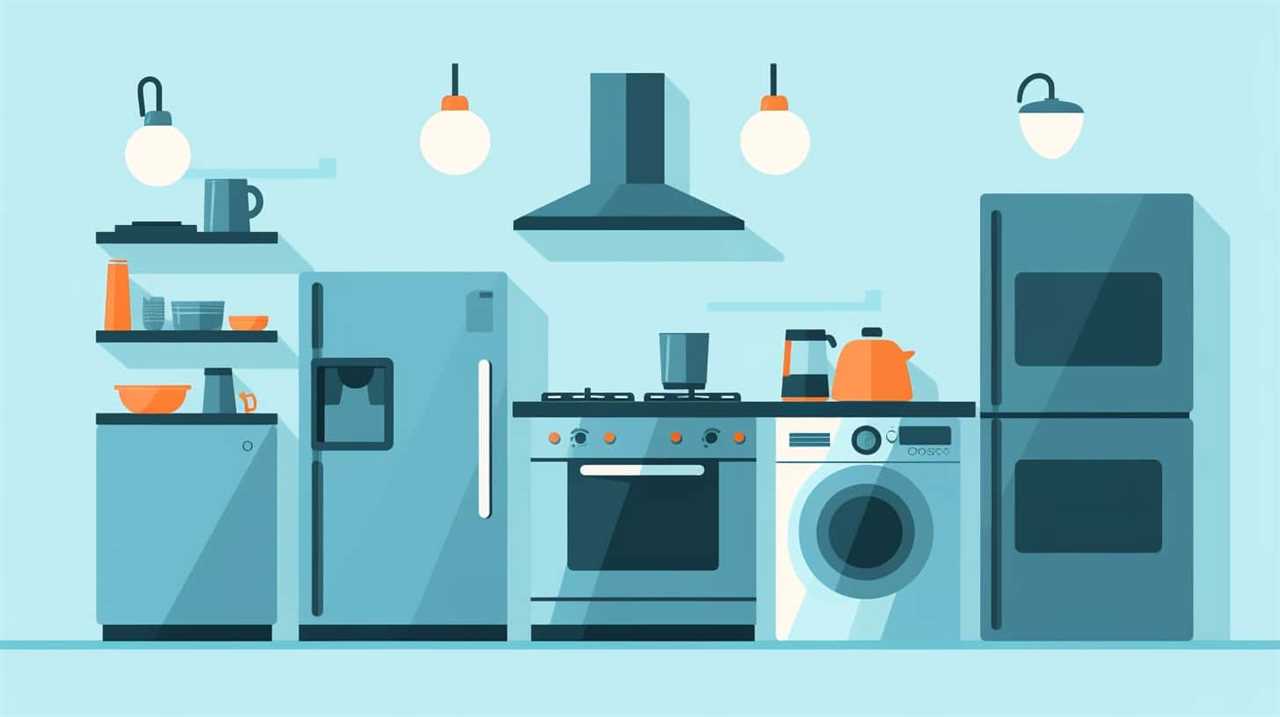
With IoT integration, homeowners can remotely monitor and manage their appliances, ensuring optimal energy usage. For example, smart thermostats can learn user preferences and adjust temperature settings accordingly, maximizing energy efficiency while maintaining comfort. Similarly, smart lighting systems can automatically adjust brightness levels based on natural light conditions, reducing unnecessary energy consumption.
Furthermore, IoT-enabled appliances can provide real-time energy usage data, empowering homeowners to make informed decisions about their energy consumption. This information can be used to identify energy-hungry appliances, enabling users to take corrective actions or replace inefficient devices.
Additionally, IoT technology enables appliances to communicate with each other, optimizing energy consumption across the entire home. For instance, a smart home automation system can coordinate the operation of appliances such as the refrigerator, dishwasher, and laundry machine, ensuring that they run during off-peak hours when electricity rates are lower.
Smart Home Automation Through Iot
By regularly automating household tasks, smart home automation through IoT technology simplifies daily routines and maximizes efficiency. With the integration of IoT in smart homes, homeowners can experience seamless control and management of their appliances, making their lives more convenient and comfortable.

Here are some key aspects of smart home automation through IoT:
- Smart Home Energy Management: IoT enables homeowners to monitor and manage their energy consumption effectively. Through real-time data collection and analysis, smart home automation systems can optimize energy usage, reducing unnecessary wastage and lowering utility bills.
- IoT Enabled Home Security: Smart home automation provides enhanced security features through IoT integration. Homeowners can remotely monitor their homes, receive alerts for any suspicious activities, and control security devices such as cameras, alarms, and smart locks. This ensures peace of mind and protection for the household.
- Seamless Integration and Control: IoT technology allows for the seamless integration and control of various smart home devices. Through a centralized control system or a mobile application, homeowners can easily manage their appliances, lighting, heating, and cooling systems, creating personalized and efficient environments.
- Increased Efficiency and Convenience: Smart home automation streamlines daily routines by automating repetitive tasks. For example, homeowners can schedule their appliances to turn on and off at specific times, adjust their thermostat based on occupancy patterns, and even automate their curtains and blinds. This saves time, energy, and effort, allowing homeowners to focus on other important aspects of their lives.
Future Trends in IoT-enabled Smart Home Appliances
As homeowners, we anticipate exciting advancements in the integration of IoT with smart home appliances, particularly in the realm of future trends. These advancements will have a significant impact on our daily lives, making our homes more efficient, convenient, and secure. Let’s take a closer look at some of the future advancements we can expect in IoT-enabled smart home appliances.
| Future Advancements | Impact on Daily Life |
|---|---|
| Voice Control | Voice control technology will become more sophisticated, allowing us to control our smart appliances simply by speaking commands. This will make tasks such as adjusting the temperature, turning on the lights, or starting the dishwasher even more convenient and hands-free. |
| Energy Efficiency | IoT-enabled smart appliances will become even more energy-efficient, helping us reduce our carbon footprint and save on energy bills. These appliances will be able to automatically adjust their settings based on our usage patterns, optimizing energy consumption and reducing waste. |
| Enhanced Security | With the integration of IoT, smart home appliances will offer enhanced security features. For example, our smart locks will be able to communicate with other devices, such as security cameras and alarms, providing us with a comprehensive home security system. |
These future advancements in IoT-enabled smart home appliances will undoubtedly revolutionize the way we live. By seamlessly integrating technology into our daily lives, our homes will become more intelligent, efficient, and secure, providing us with a higher quality of life.
Case Studies of Successful IoT Integration in Smart Homes
In exploring the integration of IoT with smart home appliances, we now delve into the fascinating realm of successful IoT integration in smart homes. Through various case studies, we can gain valuable insights into how IoT technology has been effectively integrated into everyday household appliances, creating a seamless and interconnected living environment.

- Smart Thermostat: One case study showcases the successful integration of a smart thermostat into a smart home ecosystem. By leveraging IoT capabilities, the thermostat can automatically adjust the temperature based on the homeowners’ preferences and occupancy patterns, resulting in optimized energy usage and increased comfort.
- Smart Lighting: Another case study highlights the successful integration of smart lighting solutions. By connecting the lighting system to an IoT platform, homeowners can remotely control their lights, set schedules, and even create personalized lighting scenes, enhancing convenience and energy efficiency.
- Smart Security: A successful case study in IoT integration involves smart security systems. These systems utilize IoT technology to provide real-time surveillance, remote access, and intelligent alerts, ensuring the safety and security of the smart home and its occupants.
- Smart Appliances: Finally, the integration of IoT with smart appliances is showcased in a case study where household appliances such as refrigerators, washing machines, and ovens are connected to a central IoT hub. This enables homeowners to monitor and control these appliances remotely, receive maintenance notifications, and even automate certain tasks for added convenience.
These case studies demonstrate the successful integration of IoT technology in smart homes, resulting in improved energy efficiency, enhanced convenience, and increased safety and security. By studying these examples, we can further understand the potential of IoT in transforming our living spaces.
Frequently Asked Questions
What Are the Potential Health Risks Associated With Using Iot-Enabled Appliances in Smart Homes?
When it comes to potential health risks associated with using IoT-enabled appliances in smart homes, two important factors to consider are potential electromagnetic radiation and privacy concerns.
Electromagnetic radiation emitted by these appliances, such as Wi-Fi routers and smart meters, has been a source of concern for some researchers.
Additionally, privacy concerns arise due to the collection and sharing of personal data by these devices.
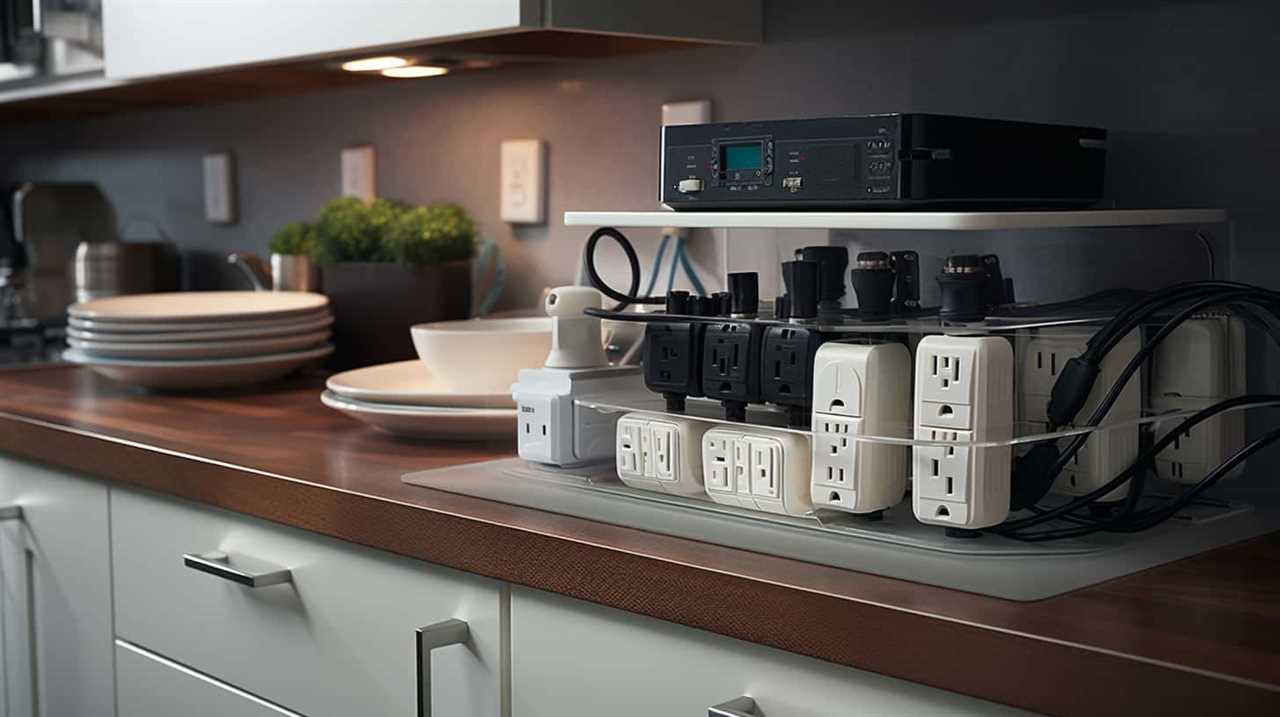
Understanding and addressing these issues is crucial for ensuring the safe integration of IoT with smart home appliances.
How Can Homeowners Ensure the Privacy and Security of Their Personal Data When Using Iot-Enabled Appliances?
To ensure the privacy and security of our personal data when using IoT-enabled appliances, we must prioritize data protection and cybersecurity. Implementing strong encryption protocols and regularly updating firmware are essential steps.
Additionally, homeowners should secure their home networks by using strong passwords and enabling two-factor authentication. Regularly monitoring network traffic and being cautious about sharing personal information online can also help safeguard our data.
Are There Any Limitations or Restrictions in Terms of Compatibility When Integrating Iot With Existing Smart Home Appliances?
When integrating IoT with existing smart home appliances, it’s crucial to consider the compatibility limitations.

Some appliances may not have the necessary technology or protocols to seamlessly connect with IoT devices. This can pose challenges in creating a unified and interconnected smart home system.
However, with proper research and planning, these limitations can be overcome by choosing compatible appliances or using intermediary devices to bridge the gap.
Understanding the compatibility landscape is key to successfully integrating IoT into your existing setup.
‘Where there’s a will, there’s a way.’

What Are the Possible Environmental Impacts of Using Iot-Enabled Appliances in Smart Homes?
Possible discussion ideas about the environmental impacts of using IoT-enabled appliances in smart homes include:
- The potential for increased energy efficiency and promoting sustainability. IoT-enabled appliances can contribute to reducing energy consumption by optimizing usage and allowing for remote control and monitoring.
- This can lead to a decrease in greenhouse gas emissions and a more sustainable use of resources.
- Additionally, using IoT-enabled appliances may result in cost savings for homeowners, as they can better manage energy consumption and reduce utility bills.
How Can Homeowners Troubleshoot Common Issues or Technical Problems That May Arise When Integrating Iot With Their Smart Home Appliances?
When troubleshooting common issues or technical problems that may arise when integrating IoT with our smart home appliances, it’s essential to have a thorough understanding of the connectivity issues that can occur.
By familiarizing ourselves with troubleshooting tips and techniques, we can effectively address any connectivity issues that may arise.
This level of mastery allows us to identify and resolve issues swiftly, ensuring that our IoT-enabled appliances seamlessly integrate with our smart home system.

How Can IoT Devices Be Integrated with Smart Home Appliances?
The role of IoT devices in integrating with smart home appliances is crucial for creating a seamless, automated living experience. By connecting these devices, homeowners can control everything from lighting to temperature using their smartphone or voice commands. This level of connectivity and convenience is revolutionizing modern living.
Conclusion
In conclusion, integrating IoT with smart home appliances offers numerous benefits, including enhanced energy efficiency and automated home control. However, challenges such as integration issues and security concerns must be addressed.
According to a recent survey, 72% of homeowners with IoT-enabled appliances reported increased convenience and improved quality of life.
As technology continues to advance, the future of IoT-enabled smart home appliances looks promising, with potential for even greater integration and automation.



